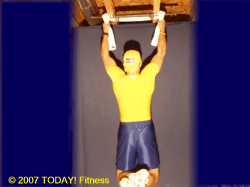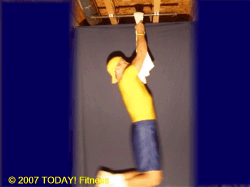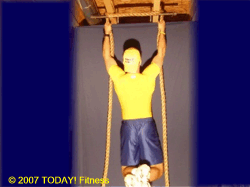|
JUST THE
FACTS |
|
I like these
little pieces of fitness trivia. Knowledge is power
and also helps you understand the how's, what's, and why's
of health and fitness (you should already know the who and
when). Here are some choice bits of information that
I thought would be good to review...
-
Fitness consists of four components: your body's
ability to use oxygen as a source of energy, which
translates into cardiovascular fitness; muscular strength
and endurance; flexibility; and body composition.
-
Nearly 2/3 of U.S. adults are overweight and half of them
(31%) are obese. About 25% of American adults are
sedentary.
-
No matter how poor your current level of fitness, you can
start an exercise routine and become fitter and healthier.
Even 90-year-old women who use walkers have been shown in
studies to benefit from light weight training.
-
According to the American
College of Sports Medicine (ACSM), American adults aged
18-65 years should
accumulate at least 30 minutes of moderate-intensity
aerobic activity 5 days per week OR engage in
20-minutes of vigorous activity 3 days per week. a
combination of vigorous and moderate-intensity physical
activity is also acceptable. New research is showing that this does not necessarily
have to be continuous, but
must be at least 10 minutes
in duration
(ie. 10min + 10min + 10min = 30 min).
-
Most moderate cardio
exercises will burn 200-300 calories per 30 minutes while you are
exercising.
-
Maximum heart rate can be
estimated as 220-your age.
Target heart rate while
training should be between 60% and 90% of your estimated
maximum.
-
ACSM also recommends
strength training at least twice weekly. Programs should
consist of 8-10 exercises for at least 1 set of 8-12
repetitions each.
-
It takes about 12 weeks after starting an exercise program
to see measurable changes in your body. However,
before 12 weeks, you will notice an increase in strength and
endurance.
-
For safety reasons, weight
loss goals should average no more than 1-2 lbs per week by
creating a calorie deficit through a combination of diet
and exercise (500-1000 calories per day). 3,500
calories roughly equates to 1 pound of body fat.
-
Abdominal exercises might
help to strengthen the muscles around your midsection and
improve your posture, but being able to see your abdominal
muscles has to do with your overall percentage of body
fat. If you don't lose the belly, you won't see the
muscles.
-
More muscle mass means higher metabolism. Higher
metabolism means that you are burning more calories at
rest. Muscle tissue has been observed to burn
roughly 7 to 10 calories per pound per day, compared
to 2 to 3 calories per pound per day for fat.
The gradual loss of muscle tissue in non-training adults
leads to a 5% reduction in metabolic rate every decade of
life.
-
1 gram of protein is 4
calories, 1 gram of carbohydrates is 4 calories, 1 gram of
fat is 9 calories. In other words, more fat means
more calories per gram.
-
The American Dietetic Association recommends consuming approximately
2/3 of grams carbohydrates per pound of body weight for endurance
athletes within 30 minutes after exercise and again every 2 hours for
up to 6 hours after the workout.
-
People focusing on strength-training require a greater amount of
protein, 15 to 20 grams, and less carbohydrates for proper recovery,
the experts say. High-quality protein from such sources as
dairy, chicken, fish, whey or soy protein are most recommended with
0.68 grams to 0.91 grams per pound of body weight suggested by
accepted sports nutrition guidelines.
-
A 5% drop in body water can reduce physical performance by
as much as 30%. A 10% drop will make you ill.
A 20% drop can kill you. It is important to consume
water approximately 20 minutes before exercise as well as
drink moderate levels of water throughout the day (8-10
glasses).
-
1 mile = 5280 feet
--- An
average stride length
is usual 2-3 feet --- On average, it takes 1760-2640 steps
to complete a mile (with the average being 2000 steps) --- The average fitness walking pace is close to a 15
minute mile. (roughly 2 miles in 30 minutes) --- A 140 pound person
will burn roughly 228 calories by walking for 30 minutes.
-
Walking at a brisk pace (a 15-minute mile or 4 mph) burns
almost as many calories as jogging for the same distance.
-
60 percent of
children do not meet average fitness
standards. Children today
expend four times less energy than children 40 years ago. Most
third graders get less than 25 minutes of physical activity a week in
school programs.
-
In Grade two, one out of
four children cannot touch their toes. 76 percent of elementary
school girls and 26 percent of boys cannot do one chin up. Half
of all teenage boys and three-quarters of all teenage girls cannot
walk up and down stairs for longer than six minutes, without straining
their cardiovascular system.
- Working out is not always
fun and easy... if it were, they would call it something
else!
|
|
MANAGING YOUR ATTITUDE |
|
I really liked the
idea of this article below and for some people this type of
mind set could be what you need to provide motivation to make
time for your workouts.
MANAGING YOUR ATTITUDE IS A
VERY PERSONAL THING.
However, for me, one of the most important factors is
exercise. My attitude and my energy levels are directly tied
to exercise. I can be doing everything else right, but without
regular exercise I can feel my attitude “heading south”.
I’ve got a friend who is 65
but looks like he’s 55. I saw him the other day and said,
“Tony, you look great.” He said, “I feel great! I got a second
job.” I said, “A second job?
I thought your import
business was doing well.” He said, “It is.
My second
job is on the treadmill from 6-7 every morning.
When I started looking at it as a second job, I showed up
whether I wanted to or not!” He said, “The
pay is lousy, but the benefits to my health and my attitude
are priceless!”
Exercise, more than anything,
is a “stress buster”. And, don’t kid yourself, stress is a
killer. In fact the World Health Organization estimates that
80% of all illnesses are
directly or indirectly caused by stress. Therefore, if you’re
not proactive in busting stress, it’s very likely to come back
and bust you!
ref:
www.simpletruths.com
|
|
|
Elite
Bodyweight Exercise of the Month! |
|
Towel or Rope Pull-Up

Summary:
Now before I start getting emails from a bunch of people
saying that this exercise is too tough, I just want to restate
my intent to provide something for everyone. No doubt,
this is a challenging exercise! I was talking to my
brothers the other day (who are also wrestling coaches) and I
mentioned that this would be my number one favorite upper body
exercise for a wrestler. You can use a long beach towel
or 1 1/2 inch manilla rope and throw it over a set of monkey
bars or a chinup bar. Between the grip work required to
hold onto the rope or towel, and the awesome pull that you get
with your back and biceps, this exercise really brings it
home.
Target:
back, biceps, forearms (latisimus dorsi, biceps brachii,
brachioradialis)
Count:
2 count
Description:
Whether you use towel or rope, begin with a high grip, arms
extended in the down position. Pull your body up so that
your elbows come to your sides. If you take a high
enough grip you could still raise your chin above the bar.
Lower yourself down in control and repeat for the desired
repetitions.
 
|
|
Specificity
in Training |
|
The
concept of specificity, sport specific training, or functional training, is
widely recognized in the field of resistance training
and holds that training is most effective when
resistance exercises are similar to the sport activity
in which improvement is sought (the target activity).
Current scientific research supports the superiority of
the specificity principle in; the type of muscle
contraction, movement pattern, region of movement,
velocity of movement, force of contraction, muscle fiber
recruitment, metabolism, biochemical adaptation,
flexibility, and fatigue.
One of the key skills
required for strength and conditioning specialists is to
analyze the movements that an athlete makes during the
task that is being targeted for improvement. If a
catcher on a baseball team wants to improve his reaction
time and speed of being able to throw a man out that is
stealing second, every component of this motion must be
analyzed and trained with the intent of improving power
and ultimately reducing the time required to complete
the task. Everything from the popping of the hips
during the upward squatting motion, to the twist of the
torso and action of the shoulder, arm, and wrist while
firing the ball must be looked at in order to make
improvements wherever possible. A lineman in football
that is seeking to improve his run-blocking will focus
more on leg strength and core stability as well as
reaction and acceleration in order to burst off the line
and drive the opponent out of the hole. In addition to
the simulation that is trained while using a blocking
sled, components of the movement will also be trained
with exercises such as the squat and dead-lift.
Specificity in training
does not only have to pertain to athletic movement…
instead it should be looked at as training for a
specific function. If the person or client is having
difficulty getting out of a chair, then training for
this particular movement should be centered around the
components of the target goal (ie. half-sits, assisted
squats, or repeatedly sitting down and getting up). If
climbing a flight of stairs is difficult, some target
exercises might be low step-ups while progressing to
walking multiple flights of stairs.
This is
not to say that an entire workout program must contain
only exercises that are specific to the activity.
On the contrary, everyone can benefit from, and should
include, total body workouts in their weekly routines.
Functional training exercises can be included in a total
body workout or they can be used to supplement
the primary exercises in order to further improve the
target activities.
|
|
It's
Go Time! |
|
My butt hurts!... I just completed my
10th year participating in the
Bike to the Bay for Multiple
Sclerosis yesterday. 75+ miles on that little bike
seat can wear on you after a while... although I would be
twice as sore if I did the ride back today! This was
my second year as a co-captain for Team Bank of America and
we had a great team turnout this year with roughly 80
registered riders (of the 1,600+ total riders). Thanks to all of you that sponsored me
for the ride.. the funds will go to a worthy cause in
support of finding a cure for this debilitating disease.
So that's
it for September, the back to school month. Physical
education or gym class is just not what it used to be.
If your child is not participating in school athletics, it
is recommended that they take part in other activities that
help to keep their body moving. The American Academy of
Pediatrics advise a minimum of 30 to 60 minutes of physical activity a
day for all children.
So remember
all of those promises that you made to yourself in the
summer? "Once the kids go back to school I'll have
more time to workout" and "I'll be able to get back into
some kind of schedule after the crazy summer is over".
Well... it's time to pay up! Even though I still don't
buy into the summer excuses, now's the time to keep your promise
to yourself. I really like the idea in the "Managing
Your Attitude" article
above regarding thinking of your workout as a second job.
Plan and schedule your workouts and take the appointment
seriously! Although you are ultimately your own boss
in this job, you're body is the paycheck and one that will
definitely be impacted by your performance!
For prior issues of this
newsletter go to
www.todayfitness.net/news.
Good Luck!
Pete
Mazzeo, CPT
pmazzeo@todayfitness.net
"You pile up enough
tomorrows, and you'll find you've collected a lot of empty
yesterdays." | |